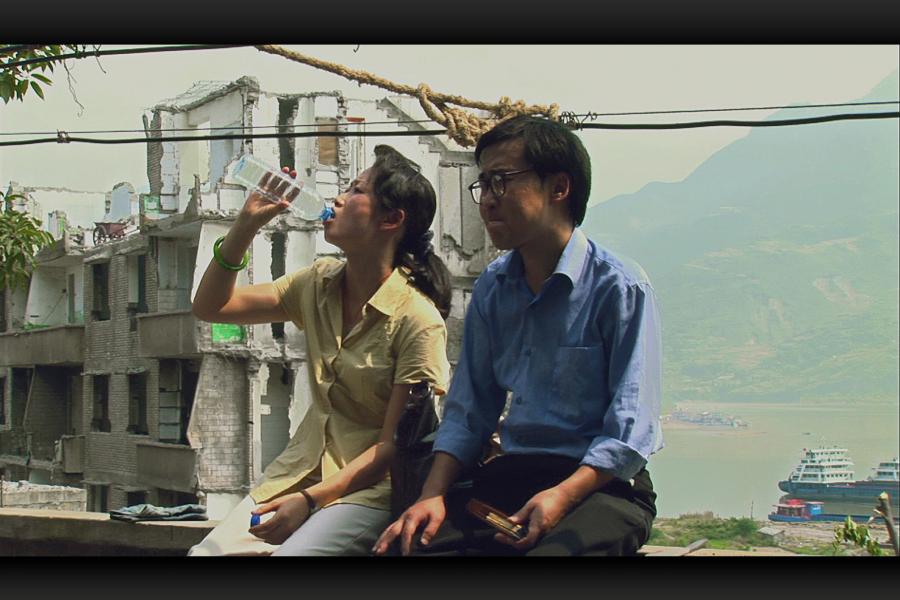What emotions do these images of animals evoke in you?


Humans
''三峽好人' ('Still Life')'
2006
Jia Zhangke
Two people sit before a deconstruction site and a river on a hazy day.
More about this image-
Bright emotions
-
Not at all Extremely
-
-
Quiet emotions
-
Not at all Extremely
-
-
Heavy emotions
-
Not at all Extremely
-
-
Sombre emotions
-
Not at all Extremely
-
Species: People (homo sapien)
Species location and habitat: Everywhere.
Conservation Status: Least Concerned (but most concerning)

Compare yourself to others
Choose different variables below, and see the patterns of response reflected in the circle of emotion above. Your responses are the coloured wedges. Others' responses are averaged in the spider graph of lines and dots.

Title: ''三峽好人' ('Still Life')'
Creator: Jia Zhangke
Date: 2006
Medium: Film
Publisher: Shanghai Film Studio & Xstream Pictures, China.
Copyright: Used with permission.
A woman takes a sip from a disposable water bottle as she sits next to a man on a hot and hazy day in a doomed city. The image is a still frame take from the brilliant 2006 film, *Still Life* (originally, 三峽好人, literally meaning 'Good People of the Three Gorges'), which uses the stories of two characters searching for lost spouses to ground a tale about breakneck modernization and it's effects on the soul. The film was shot in location in Fengjie, a city founded in 314 BC on the banks of the mighty Yangtze River, the longest river in Eurasia. Two-thousand-three-hundred-and-twenty-two years after its founding, the city was marked for flooding and was demolished. Located 160km upstream from the Three Gorges Dam, arguably the biggest architectural project on the planet, the people of Fengjie were among the 1.2 million displaced by the 42 billion tons of water that the dam holds back. This a *lot* of water. [NASA scientists calculated](https://www.jpl.nasa.gov/news/nasa-details-earthquake-effects-on-the-earth/) that the sheer mass of water stored behind the dam would increase the total length of the Earth's day by 0.06 microseconds and make the Earth slightly more round in the middle and flat on the poles. The film focus on the social ruins being slowly drowned beneath the 'economic miracle', thus grounding the massively large, powerful and abstract forces of capitalism and modernization into the specific struggling plights of characters.
Demographically speaking, this Chinese pair -- played by Tao Zhao and Hongwei Wang -- are around the median global age, thus making them fairly close to the 'average person', and as a couple, the can stand in for the basic reproductive unit of our species. For the purposes of this project, this image was chosen to represent our entire species, formally known as *homo sapiens*, sometimes *humanity*, or more concretely, *people*, or I could even use our collective noun: *us*. Rolling with the latter, *we* are living beings brought fourth by, and sustained through, the web of life. Our existence is only possible through a myriad of cycles, processes, systems and relations that compose the earth, the living natural world of which we are tiny a part. And yet, our relationship with the rest of the web of life is -- to say the least -- problematic. Millennia of hunting and land-clearing for agriculture, centuries of colonial expansion and burning fossil fuels, have set the stage for a great acceleration in the last century. It was then that the extended powers of the techno-sciences supercharged global capitalism, leading to many unprecedented developments whereby people grasped the power to remake the world, from the smallest scale of the atom and gene, through to properly global scale, such as through the recomposition of the atmosphere into a more unstable form (the process euphemistically known as 'climate change'). Slices of these transformations can be measured in various upswinging curves -- sometimes exponential -- with sharp increases in population, urbanization, GDP, energy usage, forest clearing, and toxic waste production, along with increasingly levels of carbon dioxide emissions, deforestation, ocean acidification and surface temperature increases. Because of the actions of our species, we have brought about the 6th Great Extinction in earth's history; the last major extinction even was around 66 million years ago with the fall of the dinosaurs. So much can, and must, be said about our particular species. Like none before us, we are architects of extinction, and our fingerprints are be found on all the other 99 species in this little list.





